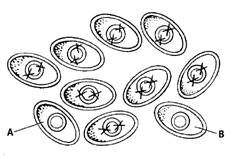
Concept explainers
Introduction:
To make large quantities of recombinant plasmid DNA, bacterial cells are mixed with recombinant plasmid DNA. Some bacteria take up the recombinant plasmid DNA through a process called transformation. Brief heating or short electric pulse creates openings in the plasma membrane of bacterial cells which allow recombinant plasmid DNA to enter the bacterial cells. However some bacterial cells do not take up the plasmid DNA.
Answer to Problem 3STP
Correct answer :
The correct answer is option C. Cells without new plasmid will die after exposure to an antibiotic
Explanation of Solution
Explanation/justification for the correct answer:
Option C. Cells without new plasmid will die after exposure to an antibiotic - The illustration given below shows bacteria that were transformed after they were mixed with the recombinant DNA. Cells A and B do not have the new recombinant DNA plasmid. After transformation the bacteria are allowed to grow on a plate containing an antibiotic. The transformed bacteria are able to survive as they contain the gene for antibiotic resistance and the normal bacteria die. Hence this is the correct option.

Explanation for incorrect answer:
Option A. Cells with new plasmid will die after exposure to an antibiotic - The illustration given below shows bacteria that were transformed after they were mixed with the recombinant DNA. Cells A and B do not have the new recombinant DNA plasmid. After transformation the bacteria are allowed to grow on a plate containing an antibiotic. The transformed bacteria are able to survive as they contain the gene for antibiotic resistance and the normal bacteria die.
Hence this is not the correct option.
Option B. Cells with the new plasmid will replicate quicker - The illustration given below shows bacteria that were transformed after they were mixed with the recombinant DNA. Cells A and B do not have the new recombinant DNA plasmid. After transformation the bacteria are allowed to grow on a plate containing an antibiotic. The transformed bacteria are able to survive as they contain the gene for antibiotic resistance and the normal bacteria die. Hence this is not the correct option.
Option D. Cells without the new plasmid will replicate more quickly − The illustration given below shows bacteria that were transformed after they were mixed with the recombinant DNA. Cells A and B do not have the new recombinant DNA plasmid. After transformation the bacteria are allowed to grow on a plate containing an antibiotic. The transformed bacteria are able to survive as they contain the gene for antibiotic resistance and the normal bacteria die. Hence this is not the correct option.
Chapter 14 Solutions
Biology Illinois Edition (Glencoe Science)
Additional Science Textbook Solutions
Campbell Biology (11th Edition)
Biology: Life on Earth (11th Edition)
Human Anatomy & Physiology (11th Edition)
Biology: Life on Earth
Fundamentals of Anatomy & Physiology Plus Mastering A&P with eText - Access Card Package (10th Edition) (New A&P Titles by Ric Martini and Judi Nath)
 Human Anatomy & Physiology (11th Edition)BiologyISBN:9780134580999Author:Elaine N. Marieb, Katja N. HoehnPublisher:PEARSON
Human Anatomy & Physiology (11th Edition)BiologyISBN:9780134580999Author:Elaine N. Marieb, Katja N. HoehnPublisher:PEARSON Biology 2eBiologyISBN:9781947172517Author:Matthew Douglas, Jung Choi, Mary Ann ClarkPublisher:OpenStax
Biology 2eBiologyISBN:9781947172517Author:Matthew Douglas, Jung Choi, Mary Ann ClarkPublisher:OpenStax Anatomy & PhysiologyBiologyISBN:9781259398629Author:McKinley, Michael P., O'loughlin, Valerie Dean, Bidle, Theresa StouterPublisher:Mcgraw Hill Education,
Anatomy & PhysiologyBiologyISBN:9781259398629Author:McKinley, Michael P., O'loughlin, Valerie Dean, Bidle, Theresa StouterPublisher:Mcgraw Hill Education, Molecular Biology of the Cell (Sixth Edition)BiologyISBN:9780815344322Author:Bruce Alberts, Alexander D. Johnson, Julian Lewis, David Morgan, Martin Raff, Keith Roberts, Peter WalterPublisher:W. W. Norton & Company
Molecular Biology of the Cell (Sixth Edition)BiologyISBN:9780815344322Author:Bruce Alberts, Alexander D. Johnson, Julian Lewis, David Morgan, Martin Raff, Keith Roberts, Peter WalterPublisher:W. W. Norton & Company Laboratory Manual For Human Anatomy & PhysiologyBiologyISBN:9781260159363Author:Martin, Terry R., Prentice-craver, CynthiaPublisher:McGraw-Hill Publishing Co.
Laboratory Manual For Human Anatomy & PhysiologyBiologyISBN:9781260159363Author:Martin, Terry R., Prentice-craver, CynthiaPublisher:McGraw-Hill Publishing Co. Inquiry Into Life (16th Edition)BiologyISBN:9781260231700Author:Sylvia S. Mader, Michael WindelspechtPublisher:McGraw Hill Education
Inquiry Into Life (16th Edition)BiologyISBN:9781260231700Author:Sylvia S. Mader, Michael WindelspechtPublisher:McGraw Hill Education





